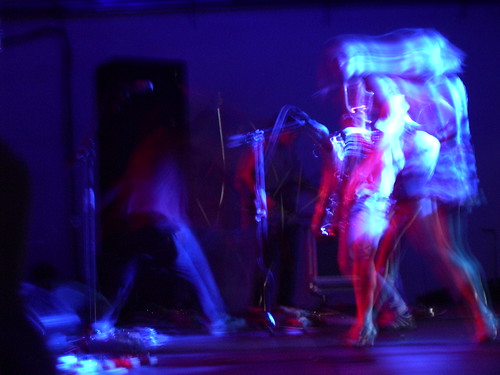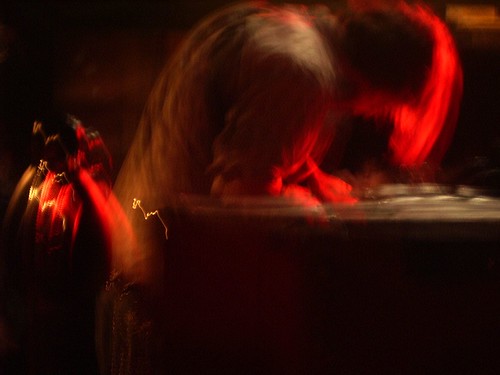


Weddings, Riots, Rock'n'Roll
The White Stripes could hardly have chosen a more iconic venue for the start of their Brazilian tour. Shipped brick by brick from Europe in the late 1800s (when three million dollars really meant something), Teatro Amazonas inspired Werner Herzog’s classic treatise on insane ambition, Fitzcarraldo, centred around the titular impresario’s effort to haul a 320 ton steamship over a small mountain (a foolhardy feat Herzog’s hundreds of native Indian extras had to recreate without the aid of special effects). The Stripes could be accused of using the movie as a metaphor for the similarly Herculean task of touring these odd venues in South America, shipping their gear from venue to venue at great expense, even installing whole new electrics set ups for the more poorly-appointed venues. Only, as Meg shame-facedly admits, “We‘ve not managed to see it yet. It was out at the video-store the whole time before we left.”
The White Stripes are the first rock’n’roll band to play Teatro Amazonas, an event auspicious enough for the Brazilian Culture Secretary Roberio Brasa to attend, his teenaged daughters in goggle-eyed throe. The venue itself is breath-taking, a puce-shaded folly of faux-Renaissance splendour and opulence, surrounded by graffiti-strewn houses with wrought-iron window-guards and piles of discarded corrugated tin that pass as shanty towns; the opera house is a reminder of the flush of money the rubber barons enjoyed at the peak of their industry, smack dab in the poverty that colours even Brazil’s lushest corners.
A quick guided tour reveals a venue rich in history and robed in fine arts and furniture, the auditorium ringed by balconies, boasting a painted curtain by Brazilian artist Crispim do Amaral, while the ceiling’s four painted pillars depict the Eiffel Tower, so someone in the stalls looking up might think they’re sitting under the tower itself. Some rooms deeper in the opera house are floored with tiles so precious, so frail, visitors have to don fluffy slippers to pad around in and admire the paintings exhibited within.
Onstage, the Stripes road crew struggles to ready the venue for stage-time, setting up their PA system, and pitting their wits against the elderly room‘s many eccentricities, to avoid the band being electrocuted when they walk onstage. Our first location for the interview, a dressing room furnished as it would have been in the Nineteeth Century, luxuriously appointed with all manner of antiques, had to be abandoned, because Meg couldn’t smoke in there. We’re now congregated in the band’s own, less salubrious dressing room, Meg receiving a pre-gig shoulder massage from band manager Ian Montone, dressed in the road-crew’s black suit/red tie/black bowler combo, while Dave Swanson, of Jack White-produced art-punks Whirlwind Heat, films the interview from the corner of the room for a projected documentary on the tour. Reluctantly, Karen leaves the room, saying that she has to try and call her mum again, that she’s had trouble getting through but she has important news for her.
“It’s a surreal life, but the best ever,” beams Jack White, snuggled in the corner on a sofa, ten or so minutes into the interview. “I’ve never felt so comfortable…”
He stops for a second, then dissolves into a helpless cackle. “Why am I so talkative today?” he asks, barely choking the words out between laughter. Then, with the generous bonhomie of a new father handing out cigars in the waiting room, he adds, “I’m having a good day… I got married today! You caught me at a good time… I’ll tell you anything you wanna know!”
They rose before dawn on the morning of Wednesday, June 1st, the day of the Teatro Amazones show, chartering a long boat to take them even deeper up the Amazon than we’d ventured the night before. The spot they chose, the confluence where the Ponte Negra and the Salimones merge into the Amazon, had special resonance for Jack, as he explains, purposefully (Jack seems to do everything purposefully, and gives the impression of entering every interview session with at least an hour or so of pre-researched spiel to share).
“I’d seen photographs of the spot many times, in the National Geographic; the waters are black and white. The guide told us there are three reasons for this…” As he begins his explanation, his brow furrows; he looks like a child trying to explain something he takes very seriously. The number ‘3’, after all, has been an obsession for White ever since he was an upholsterer in his teens, and he realised that a table needed at least three legs to stand, that the number was key in carpentry, and in life (like the 3 chords of rock’n’roll). And so what seems like an impulsive act, what amounts to an elopement, is soon rationalised with the elemental, most earthbound ‘rules’ that govern his every artistic expression. With considerable authority, he continues, “It’s because the waters are two different temperatures, two different ph levels, and running at two different speeds…”
“But eventually they must combine,” giggles Meg. She doesn’t say much in interview, more a result of her own natural shyness than any dictats on the part of her stage-brother (as has been alleged), but, like Silent Bob in Kevin Smith’s movies, what she does say is worth hearing. When discussing their woes back in Detroit later, for example, she quietly cuts to the quick of the matter, when Jack gets lost in all the surrounding issues.
It was “an inevitable thing,” he says, of their marriage. They’d met only three weeks before, on the set of ‘Blue Orchid’, the first single from Get Behind Me Satan. She, a hot and hugely successful supermodel with a willowy figure, alabaster skin, and a shock of striking copper hair, famed for shaving off her eyebrows for the cover of Italian Vogue, played the female lead.
“We just fell madly in love. It was either gonna happen today, or a year from today, some time… It was gonna happen, we knew it was gonna happen. There was no stopping it.”
They gathered at a key point - Jack, Karen, and a handful of their entourage - the sun shining upon them through the trees. A traditional shaman priest, sourced by the ever-helpful promoter Phil, married the couple, and Ian Montone, on hand as Jack’s best man, allegedly shed a tear at the ceremony. Meg was Karen’s maid of honour. Shortly after the ceremony, they repaired to Teatros Amazonas, and then on to the nearby Catholic cathedral Igreja Matriz. Within its grand white and yellow walls, mere feet from the filthy bustle of Manaus harbour market, their marriage was blessed by a Catholic priest. Jack is, after all, a traditionalist at heart. And if the idea of marrying in such haste seems uncharacteristic for the typically old-fashioned Jack White, blame it on a newfound sense of urgency since completing the troubled sessions for the new album. Or blame it on Meg.
“It was Meg’s idea,” grins Jack. “She was the maid of honour.”
“From the first time I met her, I was telling Jack, marry that girl… And he did.”
The wedding is just one reason for Jack’s high spirits today. He has, he says, experienced something of a “rebirth” since the start of the year, following a dark period beset with what Jack and Meg perceive as betrayal, as “Being burnt”.
“A lot of extreme behaviour was going on. I was fighting a lot of losing battles,” White sighs. “It was one of those moments when I felt like giving up. My mistake is, I continued living where I’m from, Detroit, after I got successful.” He laughs, mirthlessly, like he were chiding himself for his naivety. “You’re not supposed to do that. I lost a lot of friends, a lot of people burned us… It seemed like the family of musicians that we’d found, that I’d loved and that had embraced us, had in some cases turned its back on me.
“I just have too big of a heart, you know?” he continues, his face screwed up, like he’s still caught up in the confusion, the self-doubt of those days, trying to size up what the ‘right‘ thing is to do. “I wanted to know why they hated me so much. I couldn’t just blow it off, say, hey, it’s their problem. That seemed egotistical to me. Maybe it is my problem,” he ponders, for a second, before shaking his head. “I was hurting myself too much, being too open to all that. You can’t keep tearing yourself apart.”
The attacks, on his name and on his honour, came from close quarters – firstly his infamous fist-fight with lead Von Bondie Jason Stollsteimer, and then a lawsuit from long-time friend and erstwhile producer, Jim Diamond.
Jack had taken The Von Bondies along as support on an early UK tour, produced their sublimely-spooked debut album, Lack Of Communication, and was dating guitarist Marcie Van Bohlen. What media attention they were enjoying (later parlayed into a lucrative major label deal) appeared to be thanks to The White Stripes affiliation, but Jason was soon bad-mouthing his patron every chance he got, telling this journalist, back in May 2002, that Jack stole his riffs from old blues songs without acknowledging the sources, and that “Jack had little influence on the sound of Lack Of Communication, he ‘recorded’ it, more than produced it.”
Simmering tensions came to a head at the launch party for the debut album of Detroit band Blanche, on December 13, 2003, at legendary local venue The Magic Stick. Following a fracas between Stollsteimer and White in the audience, from which Stollsteimer sustained a well-publicised and photographed black eye, Jack was charged with assault and battery, to which he pleaded guilty in a Detroit court, paying $500 in fines and $250 in fees. He was told not to contact Stollsteimer, and forced to attend anger-management classes.
“People say Jack has a short temper,” insists Meg, “But he went years of being fucked-with by Jason, and not punching him. Jack had been holding himself back, you know? There’s nothing you can do sometimes. The negative people are going to get burned. You have to keep that in mind sometimes,” she muses, with a very old testament logic: “They might hurt you, but they get their ends.”
Jack, if you could have the time over again, would you still have punched Jason?
“Oh yeah,” Jack snaps back. “Very much so. It’s definitely something that should’ve happened. It should’ve happened a long time before that. I don’t know what took me so long. One of the Detroit Cobras told me about this Sean Penn movie, Mystic River, and a line about how, when you’re a leader, sometimes you have to be the janitor too. And that’s true, sometimes you have to clean house,” he concludes
Following the incident with Jason, late last year the band were sued by Jim Diamond, former member of the Dirtbombs and owner of Ghetto Recorders, the local studio where many key Detroit garage records were recorded, including The White Stripes’ eponymous 1999 debut album. Diamond was demanding past and future royalties on the first two albums, and an ‘ownership interest’ in the master-tapes.
“That’s another ridiculous situation,” sighs Jack. “He’s claiming he produced our first two albums, but I recorded our second, De Stijl, in my living room, by myself. It’s a stick-up. He called me up beforehand, and he said, ‘I’m gonna sue you, let’s settle out of court, so the lawyers don’t get all your money’. We would’ve gone back and made another record with him. He’s ruined one of the more beautiful things that’s happened in his life, the family of Detroit musicians he was a part of. He won’t be able to look back on that period and remember the great time we all had, all he’ll see is a lawsuit. I told him, I hope you feel good about yourself, because that’s one of the most disgusting things I’ve ever heard.
“I started to realise, when you fight for the truth in this whole environment we live in, then it’s a lost cause. You can’t win.”
Its characteristic of Jack White to see the pursuit of truth in terms of a battle, specifically one where the chips are stacked against him. As he’s admitted, for him such challenges serve as a powerful animus for creativity, to push him to strive for the best. But how healthy is it to place oneself in such a constantly adversarial position, to fight battles you’ve already admitted you can’t win? The album title, Get Behind Me Satan, seems to suggest a battle of epic proportions, an awful, inexhaustible enemy.
“It’s super-appropriate for everything the album is talking about,” he replies. “It can mean, You’re either for me or against me. And if you’re not going to help me, get out of my way. Or maybe it relates to the Devil’s music, and having the Devil back you up while you’re playing it. Or, perhaps it relates to aiming for the truth, for doing the right thing, and telling the Devil to take his temptations away.”
Are you spiritual people?
“I’m very spiritual. I’ve recently gotten into the cult of the Saints, in the past year. Pushed aside a lot of my musical idols, and put the Saints up there instead. The church defines them as people who have definitely made it into heaven, no matter what path they took. That’s interesting to me. I have statues of various saints sitting on top of my speaker stacks, onstage.”
Are the White Stripes an Old Testament or New Testament band?
“We’re, uh…” stammers Jack White, momentarily thrown. “I don’t know… That’s a good question. Maybe we used to be Old Testament, and this new album is the New Testament?”
It’s early Wednesday evening, June 1st, the day of Jack’s wedding, and of the show at Teatro Amazonas. The crew have pulled off another one of their so-called everyday miracles, and rewired the glorious relic in preparation for the live show. The Stripes play a brief, relaxed sound-check, Jack pounding out Stripes oldie ‘Sugar Never Tasted So Good’ on his newest toy, a red’n’white concert marimba (the only instrument he ever received a formal lesson on), and strumming Get Behind Me…’s ‘As Ugly As I Am’ with Meg cross-legged at his feet, tapping on the bongos and smiling sweetly up at him. Karen Elson - still on a very perceptible high from her wedding that morning, stumbling about the venue as if she might be dreaming, as if it’s not all quite real yet - ducks into the balcony we’re watching from, gazes over at Jack, and conspiratorially mock-swoons, before dissolving into giggles.
“See you in a bit,” she whispers, “I’ve still not managed to phone my mum and tell her... She’s going to go mental!” The next day, her local newspaper, the Manchester Evening News, announces the wedding with the bathetic headline, ‘White Stripes star marries Oldham girl’, which seems an oddly fitting description, given her absolute lack of celebrity or supermodel affectation.
A couple of hours later, and in the bathrooms the Brazilian rock kids slick their thick black hair back into killer quiffs and licks, running excitedly about the venerated hallways and hanging off the ornate balconies, screaming in adulation, looking wild and lusty, like the audience for the Muppet Show crossed with the cast of Richard Linklater’s 70s stoner memoir Dazed & Confused. The stage-lights are shaded by exquisite white porcelain shells, the plethora of red and white instruments - marimba, old vox keyboard, Meg’s drum-kit and tympani, four old amplifiers with Jack’s guitars and mandolin resting against them - scattered across a number of scarlet rugs. The black backdrop is painstakingly stitched with white palms and bushes, an apple glowing white and red at its heart. Jack’s signature, ‘I I I’, spots the stage, on the amplifiers and the guitar monitors.
A strip of white gaffer tape leads the band safely through the cluttered, blacked-out backstage, to Meg’s drumstool (white leather shaped into a crumpled ‘starlite mint’, the peppermint candies the band’s aesthetic favours, an unsolicited gift from Paul Frank, the designer and now a friend of The White Stripes). Cheering from the get-go, the audience, perhaps overawed by the grand venue, keep their seats, even as Jack ditches his black Bandit’s jacket, to reveal a blood-red shirt and black Mariachi pants, causing all the girls to scream in abandon.
They remain riveted, until the very moment Jack hollers at them, “Y’all gonna stand up or what?”. Jack then lurches over to the marimba, hammering at it and kicking his mute pedal to switch the guitar feedback on and off, unleashing an ungodly roar akin to a carnival. Which is how the audience receives it, the din riling them into an ecstatic chaos, swamping the MTV cameramen filming the show. The song is ‘The Nurse’, the first of a suite of songs from Get Behind Me Satan that pepper the set, nuggets like ‘My Doorbell’ swallowed whole by the unfamiliar audience.
Soon, Jack’s whip-sharp slide is snaring in verses of ‘Motherless Children’, and blasts of Son House’s ‘Death Letter’ howled as if Jack were some breathless, hellfire-consumed preacher. The joyful mania rises and rises, until Jack trips over a cable and hurtles strikingly into Meg’s drum-kit, sustaining purple bruises that’ll leave his leg looking like a side of ham. But he staggers back to his feet, pride and adrenaline nulling the pain, strumming the first chords of ‘I Don’t Know What To Do With Myself’, the crowd instantly singing along (the song is apparently the Stripes’ biggest hit in South America), only to break from the song a verse in.
A broad grin pulled across his face, he gazes up at the main balcony, directly opposite the stage, where Karen is standing. If there’s ever a sense that Jack is simply playing a character or putting on a performance onstage, that dichotomy dissolves in this moment, as he soaks up the joy and the romance of the moment, and sings her a deftly-altered version of Neville Fleeson’s 1920s ballad, ‘Apple Blossom Time’ (a different song to Jack’s own ‘Apple Blossom’, from De Stijl). “One day in May, You’ll come and say, Happy is the bride the sun shines on today,” he croons. “What a wonderful wedding there’s going to be, What a wonderful day.” Karen, overcome by tears, blows a kiss to her husband, the audience gazing as one in her direction. Returning finally to the Bacharach/David classic, the Stripes close out the set, leaving to chants of “Come back! Come back!”
“Excuse me,” proclaims a breathless Jack, minutes later, addressing the audience. “My sister and I want to try something special.” With that, and a Zorro-like panache, he takes Meg’s hand and bounds offstage, tearing with her down the aisle and out to the neighbouring square, Praca Sao Sebastiao, followed by a clutch of the Stripes crew, in their red and black costumed frenzy looking like Penelope Pitstop’s Anthill Mob. Like kids following the Pied Piper, the Opera House audience tear after the Stripes, as Jack and Meg set up an acoustic guitar and bongos and play a stripped-bare version of ‘We Are Going To Be Friends’ for the hundreds of kids who couldn’t get tickets for the show, watching it broadcast on video screens in the square.
It’s an electric moment, spontaneous, and not a little dangerous, given the manic fever the Stripes have whipped these kids into. The sliver of a song is cut short a verse or so in, as kids surging up from the square breach the fences keeping them from the opera house. They seep and storm from every direction, grasping at the band, ripping some of Meg’s beads, tearing Jack’s mariachi pants and snatching a couple of the Saint medallions around his neck. Karen staggers about a few feet away, oblivious to the very real threat of being stampeded by all the starry-eyed Brazilian kids hurtling towards her. She calls out to us, tears in her eyes, “This is such a magical day, I’ve married such a wonderful man…”
The duo dash desperately back to Teatro Amazonas, crew again trailing behind, followed by hordes of kids. Security shut and lock the front doors as the venue reaches capacity; the denied patrons kick and punch the doors in anger, but soon disperse and return peacefully to the video screens and the square. Our tour laminates secure us access via the side entrance, and we’re soon onstage with the crew and the band, all ecstatic, wired by the craziness that just occurred, the magic of the day at large. The remaining crowd in the opera house are chanting the riff to ‘Seven Nation Army’, which the band themselves deliver, fantastically raggedly, by way of a closer.
The moments immediately after the show are a blur, backstage swarming with chaos, the Culture Secretary’s daughters dissolving into sobs upon meeting the band, the crew scurrying to dismantle the stage, a battery of police in riot gear waiting outside. Tour manager John Baker bounds out, as fast and forcefully as his crocodile-skin shoes will allow, and barks to the cops, “Who here speaks English?” Within minutes, he has negotiated The White Stripes safe passage out of the venue, back to the hotel, but beyond a few persistent autograph-hunters, their journey isn’t much hassled. The teens still mill about the square, though, dazed and electrified by what they’ve just seen and experienced.
Back at hotel after the show, spirits remain high, and the crew and Meg stay up late into the night, drinking capirinhas (strong local cocktails mixing lime, mint, and local tipple cachacha) and, every now and again, whooping and revelling in the day’s events. Champagne is passed around, and an elaborate wedding cake, topped with fresh strawberries and cream, sits on our table in the bar, both gifts from gregarious promoter Phil.
Before disappearing off to bed, Jack White pauses and reflects on the preceding 24 hours. “That was wild, that was beautiful, in every way,” he grins. “What a great day: it started with a marriage, and ended in a riot.” That riotous atmosphere endures in the bar. Several capirinhas and slices of cake later, John Baker is swapping his gaze between the wedding cake and a minxish-looking Meg. Moments later, the cake has been mischievously smeared over the face and clothes of Mojo photographer Ewen Spencer.




No comments:
Post a Comment